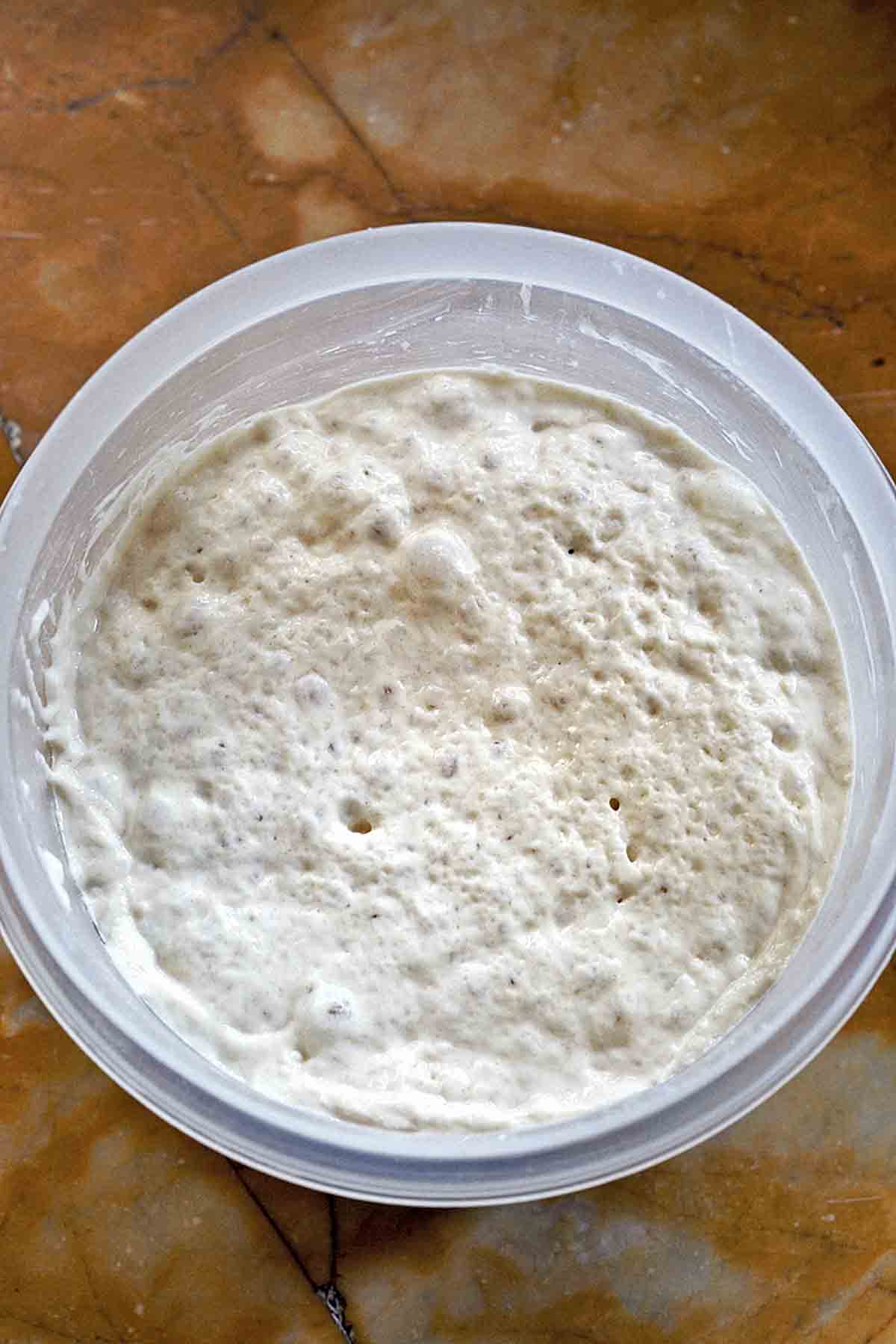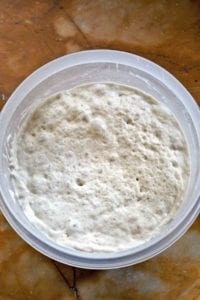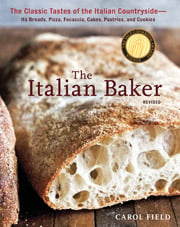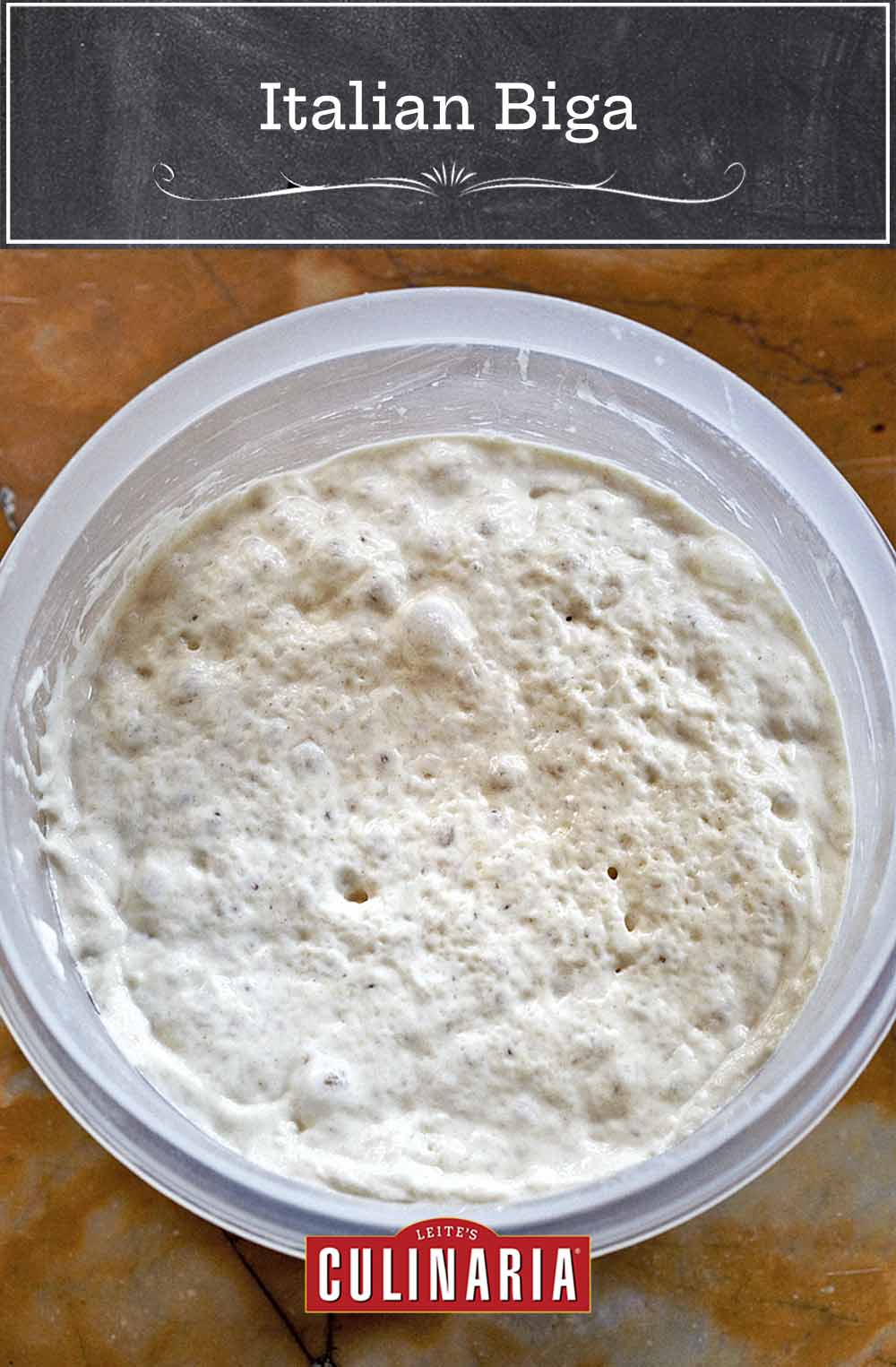
Many of the recipes for classic regional breads, such as this ciabatta recipe, begin with a starter dough made from small amounts of flour, water, and yeast allowed an initial fermentation. The starter, known as biga in Italy, or bighino when in small amounts, not only gives strength to what in Italy are weak flours, it also produces a secondary fermentation from which come the wonderful aroma, natural flavor, and special porosity of the final loaves and wheels of bread.
The important point about a biga is that the breads made with it develop a wonderful taste because their risings are long and bring out the flavor of the grain. Another benefit is that the loaves remain fresher and taste sweeter than those made with large amounts of commercial yeast.
In Italy, bakers use dough from the previous day’s baking to start a new dough. I keep some starter on hand at all times; by having it around, I can decide to make pane pugliese or ciabatta in the morning and have it for dinner that night. Because the first biga must come from somewhere, though, you may make it following the instructions below. It’s remarkable. It freezes very well and needs only about 3 hours at room temperature until it is bubbly and active again, or it can be refrigerated for up to 5 days.–Carol Field
LC Obliged to Biga Note
Behind each and every memorable bite of proper Italian bread we’ve daintily nibbled, hungrily inhaled, or otherwise somehow consumed, we have a biga to thank. So we’re feeling much obliged to Carol Field for this recipe. Nonna not included.

Italian Biga
Ingredients
- 1/4 teaspoon active dry yeast
- 1/4 cup warm water, 100°F to 110°F (38°C to 43°C)
- 3/4 cup plus 4 teaspoons bottled spring water, at room temperature (You can use tap water in a pinch.)
- 2 1/3 cups unbleached all-purpose flour
- vegetable oil, for the bowl
Instructions
- Stir the 1/4 teaspoon active dry yeast into the 1/4 cup warm water and let stand until creamy, about 10 minutes.
- Stir the 3/4 cup plus 4 teaspoons bottled spring water into the creamy yeast mixture, and then stir in the 2 1/3 cups unbleached all-purpose flour, 1 cup at a time. ☞ If mixing by hand, stir with a wooden spoon for 3 to 4 minutes. ☞ If mixing with a stand mixer, beat with the paddle at the lowest speed for 2 minutes. If mixing with a food processor, mix just until a sticky dough forms.
- Transfer the biga to a bowl lightly coated with vegetable oil, cover with plastic wrap, and let rise at cool room temperature for 6 to 24 hours, until the starter is triple its original volume but is still wet and sticky. (The bakers I admire most advise 10 to 11 hours for the first rise, but others are very happy with the 24 hours it takes for dough to truly become yesterday’s dough, and if you like sour bread, allow your biga to rest for 24 to 48 hours or even 72 hours.)
- Cover and refrigerate or freeze the biga until ready to use. (If refrigerating the biga, use within 5 days. If freezing the biga, let it rest at room temperature for about 3 hours until it is bubbly and active again.) When needed, scoop out the desired amount of biga for your recipe and proceed. I strongly recommend weighing the biga rather than measuring it by volume since it expands at room temperature. If measuring by volume, measure chilled biga; if measuring by weight, the biga may be chilled or at room temperature.

Nutrition
Nutrition information is automatically calculated, so should only be used as an approximation.
Recipe Testers’ Reviews
This is a perfectly suitable starting point for most any bread which uses a starter. I bake bread several times a week and it’s nice to have this handy. Sometimes I add this to a bread dough which doesn’t call for a starter just for the added flavor.












Thank you for this wonderful biga recipe. It is going on 13 hours and bubbling beautifully. I am wondering if the same ingredient replacement method applies for the biga as the sourdough starter recipe I use. For example, if I use one cup of biga for a ciabatta recipe do I put back into the biga one cup or 140 grams of AP flour and one cup or 236 grams of water? Also is one cup of biga considered 236-240 grams?
Melissa, lovely to hear your biga is bubbling beautifully! I’ve queried our resident bread baking professional about the replacement and she or I will be back in touch very shortly. Thanks for your patience!
Many thanks…In addition to the question s I already asked you…I have one more for you if that is okay… Do you think that after the biga is ready…like really bubbly and thick, I should go ahead and put it in the fridge at that point? I ask because if I leave it for 24 hours at room temperature, it remains bubbly, but it shrinks in the bowl. I live in Israel and it is very hot in Jerusalem now, even at night. I would appreciate your advice on that. I made the ciabatta using your biga and the Food Network’s bread recipe and it was lovely. Thank you again & kind regards…
Melissa, I heard back from our baking guru and here is what she has to say…
Yes, go ahead and refrigerate it. It’s hot here now, too, and I leave my starters out for much shorter times when it hits 80°F or higher in my kitchen. Allow it to come to room temperature to use it.
Regarding the question of replacing the biga: As the reader suggests, to keep any starter going you just feed it. Carol Field’s biga is about 79% hydration; feedings should maintain that ratio. The recipe makes about 590 grams of biga. Ms. Field’s ciabatta recipe uses 500 grams of the biga so there will be about 90 grams left. To maintain the hydration ratio and restore the biga to the original quantity of 590 grams add 220 grams of water and 280 grams of flour.
Oh yeah, one cup of biga according to Ms. Field’s recipe is about 8.8 ounces or 250 g. Not all biga or starters weigh the same per cup. It depends mainly on hydration and also the flour or flours used. Plus when it was last fed and how much it has been stirred down. Weighing is the better way to measure.
I gave these amounts by weight because everyone weighs flour a little differently. Our reader uses 140 grams per cup. I generally use 130. Ms. Field, in this recipe, uses 133. Using Ms. Field’s 133, the additions to replenish the biga translate to about 7 1/2 fluid ounces (call it just under 1 cup) of water and 2 cups plus 1 tablespoon plus 2 teaspoons (call it just over 2 cups) of flour. Most starter recipes that require adding equal parts flour and water mean equal parts by weight.
Hi Renee and thank you for all the information. I made the ciabatta recipe this evening…and it came out amazing. The crust was much crispier and the holes bigger in the crumb then the FN recipe I made a few days ago. It is a bit of work…but really worth it. The only thing I would like to improve upon is the rise. A tad higher, & I’m not quite sure how to achieve that. Maybe next time I will need to work the dough less. Definitely a hit though in the Segal residence.
Melissa, you’re welcome and thank you for letting us know how well the ciabatta turned out! I’m thrilled to hear you had as good an experience as we did with the recipe. And yes, working the dough a touch less should make for a slightly higher rise. I’ll also ask the bakers I know if they have any hints and let you know if I hear anything that could be of help.
Thank you for offering…What a wonderful site this is!
Should one stir the biga whilst fermenting or is it best left alone?
Hi Mary, once you mix the biga, there is no need to stir it again while fermenting.
I wish this comment was pinned to the top! After making the ciabatta, I scanned through the comments about what to do with the leftover biga. There were comments but nothing specific with weights related to what I had leftover. So I just estimated, trying to make it look like it did at first (though I don’t remember what the volume was). I think I don’t have as much as the original biga started as.
I’m so glad this was helpful to you, TracyKM! Greatly appreciate you taking the time to let us know. Makes sense what you did. And next time you’ll know to weigh it. Keep in mind, you can freeze the biga, too…
Made three biga batches so far, two still in the fridge and one that baked up fine following the ciabatta recipe and which everybody loved as an appetizer to dip in garlicky olive oil. My bigas were/are not very liquid-y either, and all ingredients got weighed carefully in grams. I can reach in and give it a fold without having it stick to my dry hands.
I add about a tablespoon of a more runny starter I’ve been maintaining for a year, just to give the baby yeasties some adult supervision. The water is tap water (hard well water) and the flour either Safeway Organics AP flour or King Arthur AP flour. Sometimes I add 50 g of whole wheat, and plan to add 50 g rye when I next buy some. I would like to know how to turn this tasty biga into baguettes!
PS: I live in the high desert at 4700 feet and the daily humidity is in the 15 to 25% range.
Hi Potimarron, I spoke to one of our master bakers and she suggested that rather than adapt this recipe for a baguette, you use a recipe designed for baguettes. Perhaps one of these recipes for bread or baguettes.
I have everything I need to make the recipe but wanted to clarify the ability to refrigerate or freeze it. I see that the picture shows the Biga in a plastic container (like the ones from Chinese Takeout Soups) and there is one mention of double freezer bagging for up to three months. Being disabled freezer bags are luxury item so I was wondering if I could use a glass jar that previously contained sauce or salsa? Thus the size would be volume upward and not outward. Can you let me know if that is okay?
Thank you,
Sicilian Casualty
Hi Sicilian Casualty (what a name!), once the biga has risen in an oiled bowl, it should be fine to transfer it to a container for freezing.